Along with pinch blisters, heel edge blisters are the most common blisters we see at ultramarathons. On more than one occasion at the Adelaide 6-Day Ultra 2019, we saw posterior heel edge blisters caused by orthotics. Specifically, orthotics that were ever so slightly out-of-place in the shoe.
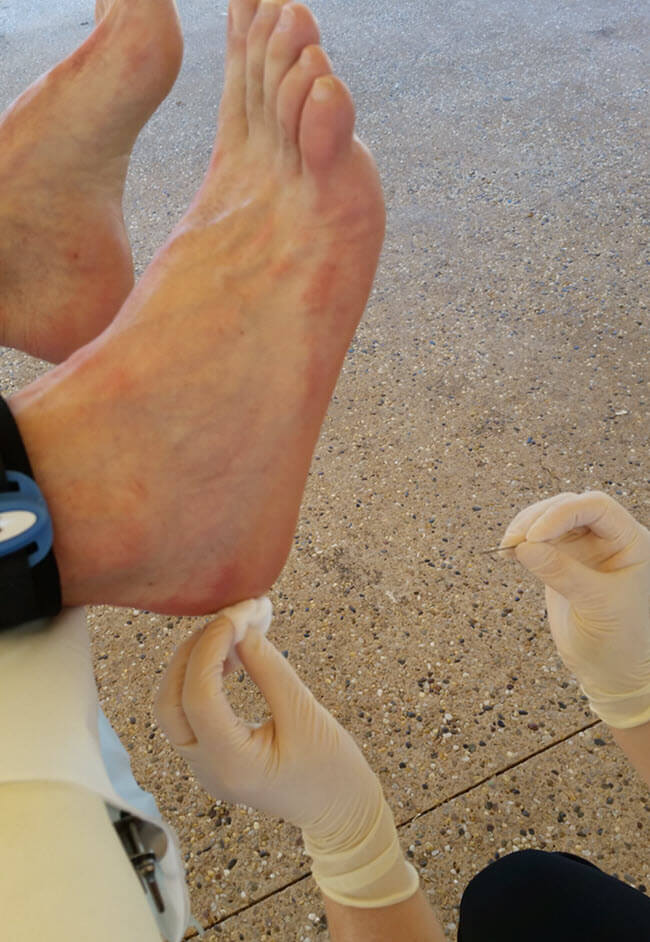
Orthotic Position
A foot orthotic is designed to sit right to the back of the shoe. This way, the heel cup contours seamlessly into the heel counter of the shoe, providing an adequate and seamless space for the heel to sit.
However, it’s not uncommon for an orthotic to slip a little forward, and stay there. Step after step, the bottom of the orthotic makes a little groove into the shoe, and the orthotic nestles into that position by default. The result is, the heel is effectively sitting on the back of the heel cup.
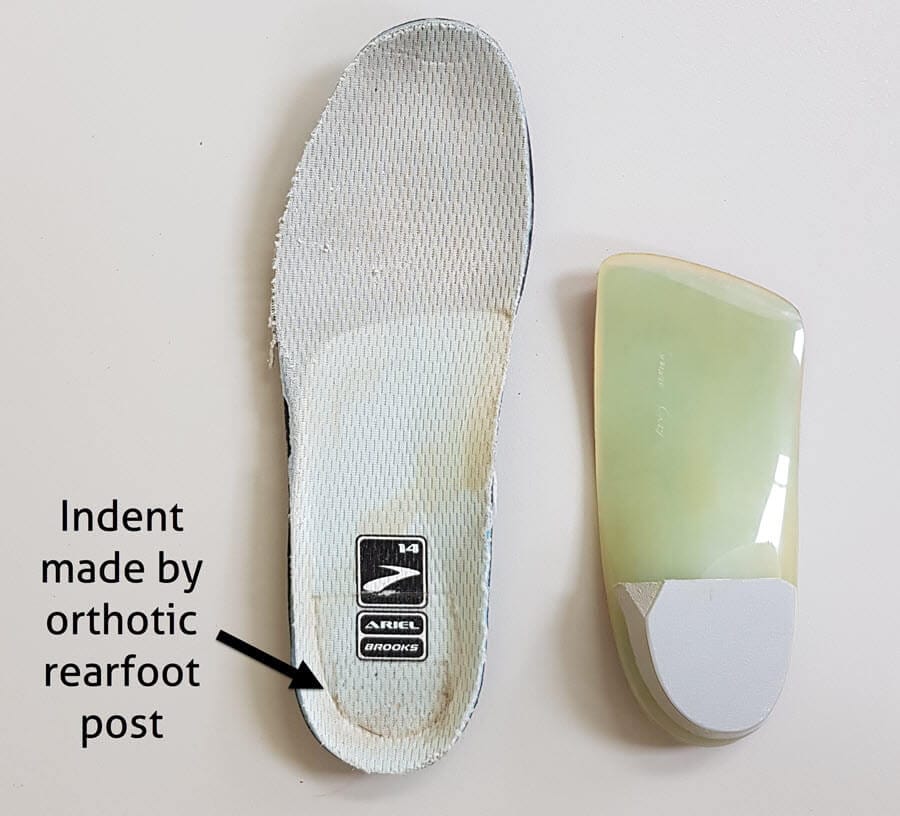
This malposition is often undetected by the wearer, and not a problem when activity levels are low to moderate. But throw 2, 3 or 6 days of continuous running and walking into the equation, and it can soon become blister-causing.
How Do You Know If Your Orthotic Is In The Right Place?
Simply feel for a gap between your orthotic and your shoe. It might be as little as 3mm – that’s still significant. Certainly 5mm will give trouble!
Another tell-tale sign is callous at this very location on your heel. Remember, callouses and blisters are caused by the same thing – callous is the chronic result of skin shear, blisters are the acute result.

Where Do The Blisters Appear?
In the instance of an orthotic that is sitting too far forward, heel edge blisters will result at the back of the heel edge (rather than the sides). This is where the concentration of pressure is.
As the blister develops, you’ll notice the blister fluid will gather above the point of irritation. Why? Quite simply, it can’t stay where it’s constantly being pushed on. It will follow the path of least resistance and get pushed to a less pressurised and less weightbearing area, ie: upwards.
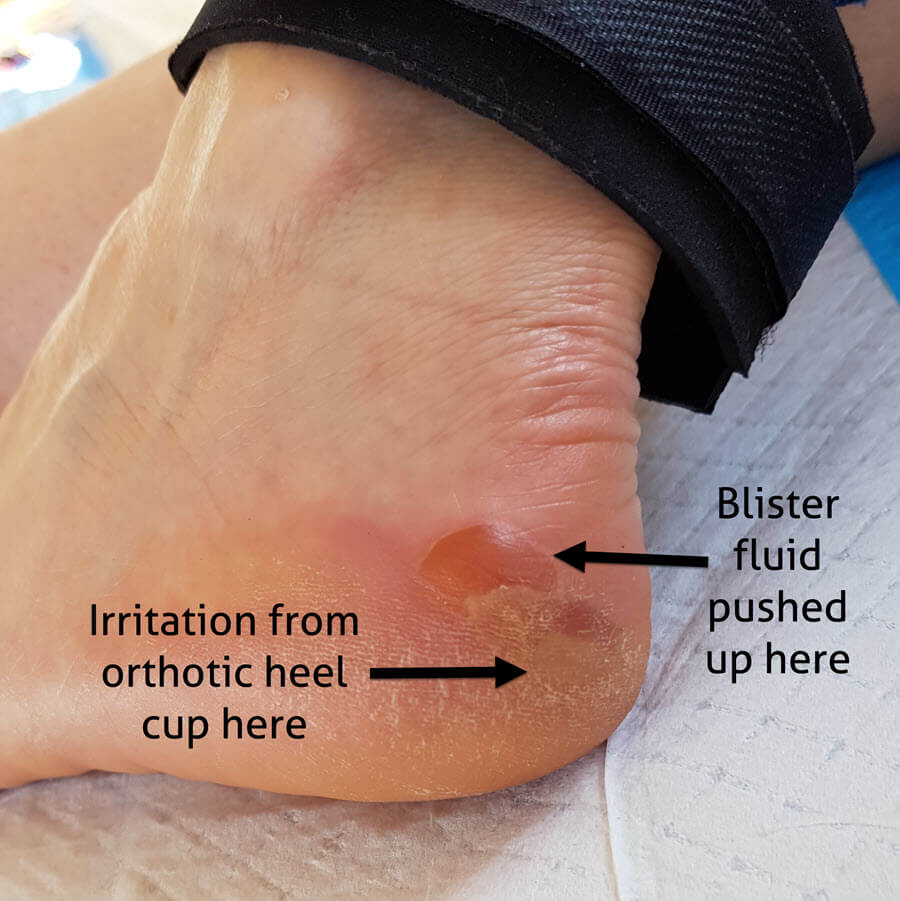
So you must not be fooled into thinking the cause of this blister is higher up. If you concentrate your efforts here, they will be wasted. Hold your orthotic against your foot and you’ll see the area being irritated.
How Did We Fix It?
It’s not enough to move the orthotic back and assume it will stay there. You have to make it stay there so it doesn’t cause posterior heel edge blisters. And the best way to do that is with a piece of double-sided tape under the heel of the orthotic. Place the orthotic appropriately in the shoe, press down HARD, and then put the shoe on carefully. It’s best to undo the laces so you can ensure the correct position is maintained as the foot slides into the shoe. Otherwise, you’ll just reinforce the orthotic in the wrong position.
What Else Did We Do?
By fixing the orthotic into the right position, we’ve taken care of the pressure component of blister causation.
And finally, I’ll usually attempt to spread shear load by using a rigid sports tape over an area much larger than the irritation itself.
- For the sake of a long-lasting adhesion, I first apply Fixomull Stretch (sticks really well to the skin).
- Followed by rigid Elastoplast (does the job of spreading shear load).
- Followed by another layer of Fixomull (as a fixation for the Elastoplast to ensure edges don’t roll back).
These posterior heel edge blisters are easy blisters to proactively prevent. Make sure your orthotic is sitting in the right place in all of your shoes. If it’s not, head to Bunnings and grab a strong double-sided tape. Problem solved. And remember how helpful ENGO Blister Patches (the oval shape) can be at reducing friction levels.

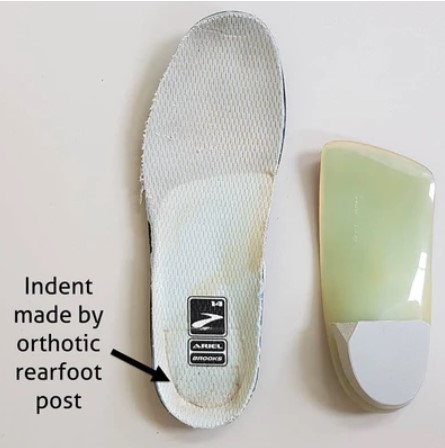

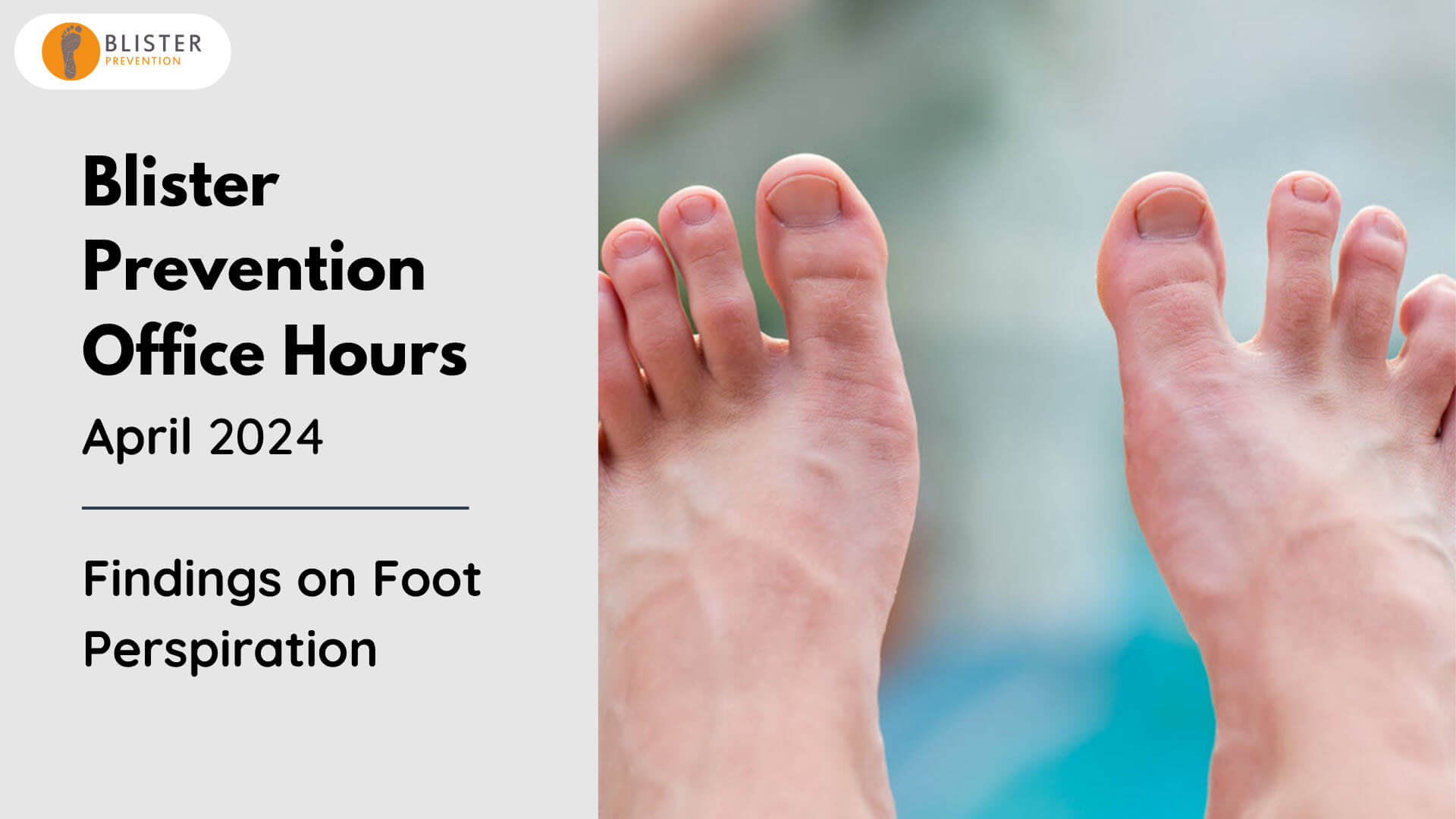
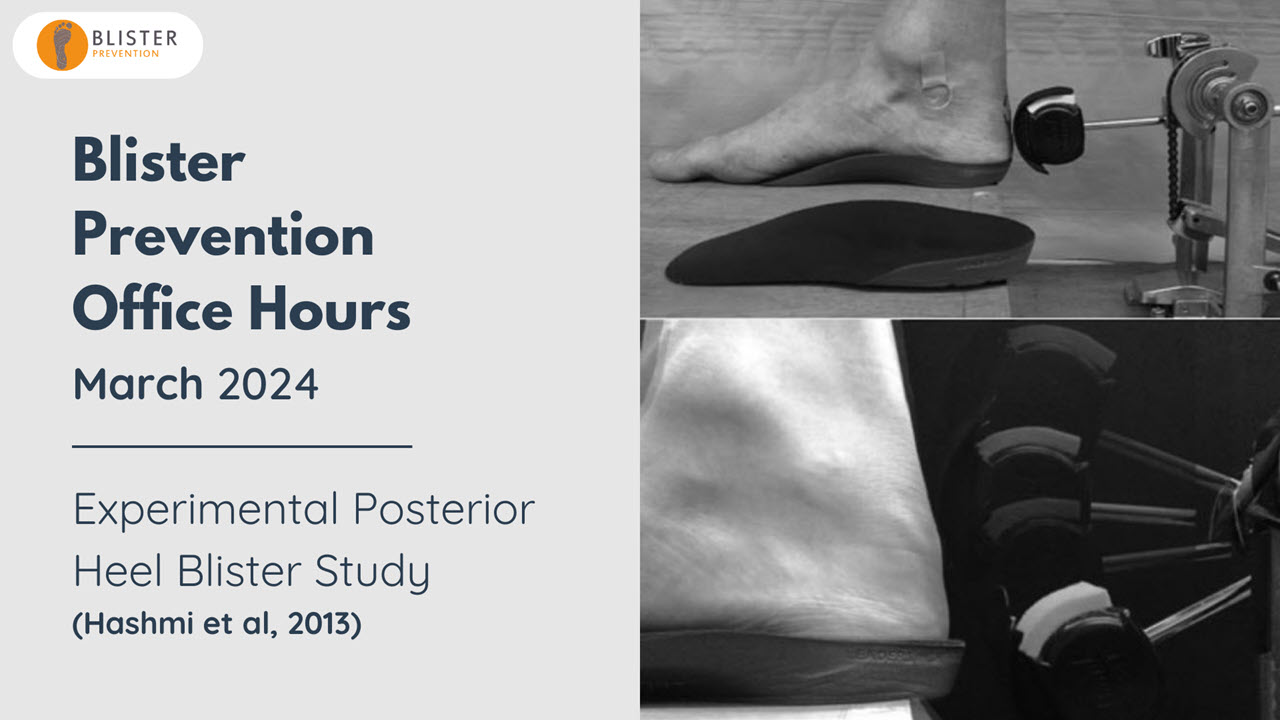

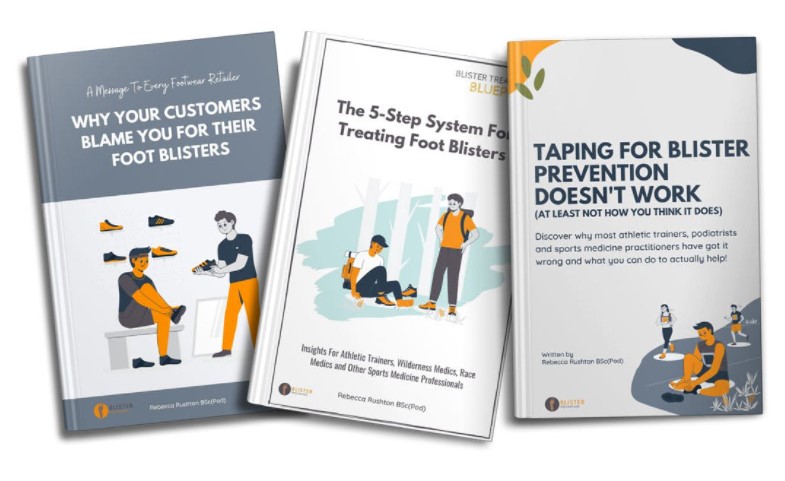
8 Responses
Remember it’s best to apply ENGO Patches when your shoes and insoles are dry. Using two patches is a good idea to avoid creases in the patches. If your shoes have a sewn in tongue, it will be a challenge to get the patches in place inside the front of the shoe. You can try to curve the patch, sticky side out, around a one finger, using a finger under and above to hold it in place, and insert it in that way.
Hi There
I bought the engo patches after having done some research after heel edge blisters when training for a 54 mile hike. At 20 miles, I still got some blisters/sore skin on my outer edge of the heel. Do you have any ideas on taping this area too? I doubt I can make the 54 miles at present.
Dawn UK
Hi Dawn. I’m sure I can help you out here.
Can you email me 3 photos: 1) The area on your foot that’s sore 2) The innersole you have one of the patches on 3) the patch in the shoe … to [email protected]
In the meantime Dawn, here’s a video on taping heels: https://youtu.be/h8DrWC_jYyc?t=1m11s
Rebecca
Hello. I was wondering if there is a way to determine if I am developing a bunion or if my pain is simply caused by an edge blister. I play tennis a lot and developed a combination of a callus with a blister in the center that comes and goes, as it heals, peels and starts again. I followed your instructions to for applying the Engo patches to my tennis shoes and it has greatly helped keep in preventing any further blisters. However, the ball of my left foot where the callus has formed has become very sore. It is near the area where most bunions are. I have never had bunions before, but this area remains red and feels like the bone is bruised underneath. I could send a picture if this would help. I am not sure if I need to purchase new shoes and see if a wider toe bed could help in case this is being caused by my ball of my foot hitting the insole in a bad way. I was going to make an appointment with a podiatrist but my insurance company says I would have to see an orthopedic doctor instead and I’m not sure if they will be educated enough specifically on feet to help or not. Thank you.
Hi Sonja. There’s a couple of things that might be causing this pain. And the only way to know what’s going on is to have someone look at your feet – not only their structure but the way they function. Either way, with the Engo patches, you can be sure you’re taking care of friction levels as much as you possibly can. Pressure and bone movement are another thing though and a podiatrist (or possibly orthopedic doctor) will help figure out what’s relevant and what your next step is.
Thanks for the info and page. I’m training to do part of the Camino next year, 115kms and have some days of 24/22kms. I find when I wear what I call my hiking shoes (not boots but trail shoes) I get a hot spot on the edge of my big toe pad area on the right foot only, with the starting of a blister deeper underneath. And only a little on my left. But when I wear my Asics Gel sneakers I don’t get this hot spot, in fact I can wear those shoes the next day quite comfortably. Question is….do I try and work out whether it’s the shoes shape and get new trail shoes that don’t cause this friction, or do I patch the existing shoes? I currently rub Vaseline into my feet and then wear my socks to reduce rubbing, that does help. I’m going to try one of my longer walks (as that’s when I get the prob) wearing my trainers and see what happens. Any help appreciated. Cheers
Hi, this is the first great article I have found to explain heel edge blisters well. In my hiking boots, I used Superfeet green. After a big day in the hills, the outside of my right heel would be slightly sore, but no blister. That was until I had the winter off. Upon starting back I got a heel edge blister on both heels. I thought it was time to replace my boots. I replaced my hiking boots, for the same make model and size as previously. I treated myself to a new pair of Superfeet Active Cushion High Arch as recommended by their site. Despite new boots and insoles, the blisters kept coming, I tried thick and thin hiking socks. Whilst the thinner socks help a little, it doesn’t prevent the heel edge blisters. I have even loosened the laces off thinking it could have been the heel being too tight against the heel cup. I have tried different lacing techniques, even though it doesn’t feel like the heels are lifting. I would love to get your thoughts on this. Thank you.
Read this article about edge blisters that include the side of the heel Steve, rather than just the back of the heel.
My thoughts and advice are contained within.